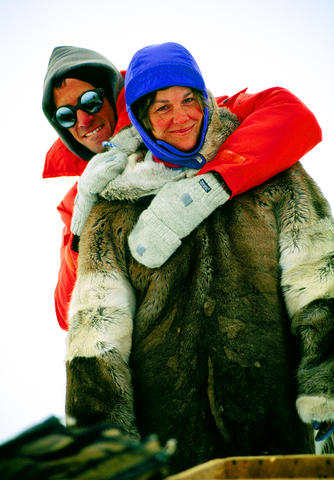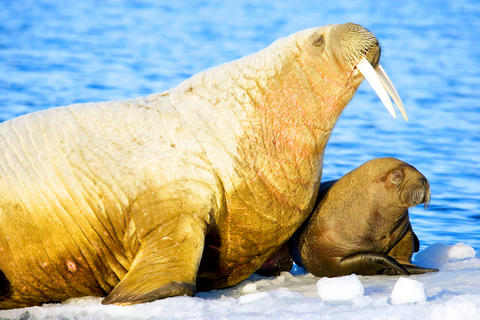There is something unnerving about watching a polar bear stalk across floating sea ice high in the Arctic and doing so from the frigid waters directly beneath the bear, the world's largest four-legged predator.
Overhead, through ice so thin that it is transparent, plate-size paws set down, one after the other, as the half-ton animal pursues its prey.
Gripping moments like this abound in Arctic Tale, a new film exploring challenges facing polar bears and walruses, two familiar denizens of the icy, but warming, seas at the top of the world. But Arctic Tale is not a typical addition to a lengthening line of somber documentaries on dangerous or endangered wildlife.

PHOTOS: NY TIMES NEWS SERVICE
Instead, Adam Ravetch and Sarah Robertson, a husband and wife who have spent the better part of two decades filming the Arctic's hulking, reclusive and sometimes deadly mammals for television nature shows, sifted through more than 800 hours of their own footage and that of other filmmakers to assemble a fictional, family-friendly coming-of-age tale.
laughter and tears
The film follows this unorthodox gambit to tell of the entwined lives and travails of two composite characters, Nanu, a young bear, and Seela, a walrus. Their stories are related, fable style, by Queen Latifah, and include scenes ranging from the wrenching, when a bear cub falters and fades in a relentless blizzard, to the comic, when a heap of basking walruses erupt into a flatulent chorus after bingeing on clams. (An adult can eat 4,000 a day.)

Arctic Tale is clearly aimed at the same audiences that flocked in unexpected numbers to An Inconvenient Truth, which chronicled Al Gore's climate campaign, and March of the Penguins, which followed the life cycle of rugged inhabitants from the other frozen end of the world. But Adam Leipzig, the president of National Geographic Films, which produced the film, said the project was conceived two years ago, before either documentary became a hit. The idea, he said, was to make a wildlife film "that really holds up as a movie." (Paramount Classics will release the film in the US in mid-August.)
Some early reviews have questioned the value of assembling footage of various animals at different life stages to construct artificial life stories complete with human-like villains and heroes, including a walrus Auntie who gives her life in defense of Seela.
The trade newspaper Variety noted that "the anthropomorphism is relentless, as animal communities are mined for their most recognizably human characteristics - not hard to do, given the outsized personalities of the main subjects."

Leipzig defended the approach, saying the goal was to create a new genre of "wildlife adventure" movies.
docu-soap
"It isn't fictionalized in the way that Transformers is fictionalized," Leipzig said. "This genre is movies about the creatures of the world as they actually exist, with their real behaviors documented by the foremost wildlife cinematographers in the world and crafted into stories that can entertain and educate audiences and where there are deep resonances that audiences can respond to."
Ravetch, like Leipzig, sees the emotional power of the film flowing from the images and moments more than the imagined story.
"When you see a mother hug an animal, that's undeniably an act of emotion and caring," he said. "In the scene where a mother polar bear has to cast off the baby because she can't fend for the both of them anymore, it's got sort of that tough-love feel. But you see that emotion in the footage."
Providing the characters with names, Robertson said, makes it easier to relate to the animals through the stages of their lives. The Hollywood tactics also ensure that the movie plays as a parable about adjusting to changing conditions on a warming planet.
The Arctic in recent decades has experienced sharp warming and a dramatic pullback of sea ice in summers, developments that many climate experts attribute at least in part to the buildup of carbon dioxide and other heat-trapping emissions in the atmosphere. Should these recent trends persist, they say, later this century the Arctic Ocean - routinely cloaked with sea ice for thousands of years - could be open blue water in summers.
The shifting conditions prompted federal scientists last December to propose a "threatened" listing for polar bears under the Endangered Species Act and a fresh assessment of the species' prospects is under way.
Polar bears, partly due to animated Coke ads and dozens of zoo exhibits, have carved out a cuddly place in popular culture, but up close and personal they are ferocious predators, making the task of collecting the raw footage for the movie a daunting exercise. All wildlife filming has its challenges, whether in the Amazon, Himalayas or Serengeti. But it would be hard to top the difficulty of filming polar bears outside the few spots where they congregate in significant numbers, like Churchill, Manitoba, except perhaps if one's quarry is walruses, which are even larger (big ones can exceed the dimensions of a Mini Cooper) and can be just as dangerous if spooked.
The challenges are amplified if the filmmaker's goal is to chronicle the lives of these species both above and under the floating ice, which is where Robertson and Ravetch, a seasoned diver as well as wildlife cinematographer, have gone repeatedly since the early 1990s.
shrinking world
Often with their children in tow, they spent season after season pursuing pivotal scenes in the lives of their quarry: the tentative first foray out of a snow-covered den by two polar bear cubs, after which one topples backward comically into the hole; the embrace of a walrus calf, umbilical cord still trailing, in the surprisingly dexterous flippers of its mother; the tutorials in which a mother polar bear shows cubs how to reach a seal cached in layered sea ice by rearing up to full height and hammering stiff forelegs downward; a chilling attack by a polar bear on a walrus amid a great jiggling panicked mass of the tusked marine mammals.
Ravetch said he has seen Arctic conditions shift starkly since 1990, when he and Robertson started filming in the far north. Around Baffin Island in northern Canada, he said, where thick ice was the norm in springtime years ago, seas are often a dangerous slushy mess.
In one scene a mother bear and cubs are seen tentatively crossing such disintegrated ice, which gives like a waterbed underfoot.
"We've seen these areas getting warmer to the point where this last year by April it had been raining for three months," Ravetch said.
Another reason for having named, if composite, animal characters, Robertson said, was "to give climate change a face."
"Climate change is a bunch of statistics for many people," Robertson said. "But regionally climate change is affecting not only people but animals. We wanted to really settle in on the moments and the decisions and reactions of animals when they are faced in regional areas with climate change."
Despite the challenges of the ice retreat (the ice helps polar bears, for example, stalk and ambush seals, and is a haven for walrus pups), she and Ravetch said they were convinced that both species would endure. "Polar bears and walruses are resourceful learners, so over the short term they'll find new ways to hunt and live," Ravetch said. "But they can't do the impossible, and in the long term we really don't know what will happen to them, which is true also for ourselves. It's going to be a journey for every creature on the planet."

June 9 to June 15 A photo of two men riding trendy high-wheel Penny-Farthing bicycles past a Qing Dynasty gate aptly captures the essence of Taipei in 1897 — a newly colonized city on the cusp of great change. The Japanese began making significant modifications to the cityscape in 1899, tearing down Qing-era structures, widening boulevards and installing Western-style infrastructure and buildings. The photographer, Minosuke Imamura, only spent a year in Taiwan as a cartographer for the governor-general’s office, but he left behind a treasure trove of 130 images showing life at the onset of Japanese rule, spanning July 1897 to

One of the most important gripes that Taiwanese have about the Democratic Progressive Party (DPP) is that it has failed to deliver concretely on higher wages, housing prices and other bread-and-butter issues. The parallel complaint is that the DPP cares only about glamor issues, such as removing markers of Chinese Nationalist Party (KMT) colonialism by renaming them, or what the KMT codes as “de-Sinification.” Once again, as a critical election looms, the DPP is presenting evidence for that charge. The KMT was quick to jump on the recent proposal of the Ministry of the Interior (MOI) to rename roads that symbolize

On the evening of June 1, Control Yuan Secretary-General Lee Chun-yi (李俊俋) apologized and resigned in disgrace. His crime was instructing his driver to use a Control Yuan vehicle to transport his dog to a pet grooming salon. The Control Yuan is the government branch that investigates, audits and impeaches government officials for, among other things, misuse of government funds, so his misuse of a government vehicle was highly inappropriate. If this story were told to anyone living in the golden era of swaggering gangsters, flashy nouveau riche businessmen, and corrupt “black gold” politics of the 1980s and 1990s, they would have laughed.

Imagine being able to visit a museum and examine up close thousand-year-old pottery, revel alone in jewelry from centuries past, or peer inside a Versace bag. Now London’s V&A has launched a revolutionary new exhibition space, where visitors can choose from some 250,000 objects, order something they want to spend time looking at and have it delivered to a room for a private viewing. Most museums have thousands of precious and historic items hidden away in their stores, which the public never gets to see or enjoy. But the V&A Storehouse, which opened on May 31 in a converted warehouse, has come up